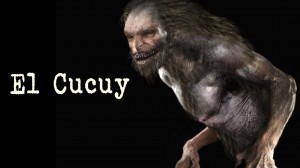Main Piece: “El Cucuy is a myth that was basically a tall, furry, red-eyed creature, that had a large red ear which he would use to hear children that were misbehaving. He would live in the hills or the mountains in Mexico, and by using his larger ear he would listen for children that were misbehaving. He would then come down from his cave in the mountains, and would kidnap any kids that he heard misbehaving… he would take them back to his cave… and then he would eat them.”
Background: UV said that he lived in an area that was very mountainous, and so this story circulated around from his family and from people that he knew from school. There was always this fear of the unknown in the mountains, and UV said that because kids liked to play in the mountains, this story was another way to scare kids into not messing around in the dangerous area. Additionally, UV said that El Cucuy was often seen as a boogie man, and that essentially this was another way to remind kids to not only stay away from the mountains, but also to be good.
Context of Performance: UV told me this story at my apartment while we were discussing the classic stories and myths we were told as a kid. UV mentioned that many of the myths he was told as a kid had some kind of ghoulish element to them, or some cautionary aspect to it. There were also a couple other people in the room during the story, and one of them had also heard this story but he grew up in Arizona, so it was interesting to see that this crossed country lines.
Analysis: This story is very interesting to me for a number of reasons. Much like the story of La Llorona that UV told me earlier, this story also functions as a cautionary tale for children. It seeks to remind them that acting out of line or misbehaving, can have serious and drastic consequences. The other thing that sticks out to me is that it would appear that while similar in nature, they differ in their setting. So it would appear that regionally a story such as La Llorona may not work as well for people who live near the mountains or in dryer areas. But setting the ghoulish presence in the mysterious settings of the mountains would certainly draw more fear and believability out of the folk in the area. I find that this story is very much concerned with reinforcing the themes of obedience amongst children, and ensuring that they are fearful of disobeying their parents or other authority figures. And it also functions as a way to keep the children safe, as it discourages them from exploring the mountains where there could be any assortment of dangers rooted in them.

